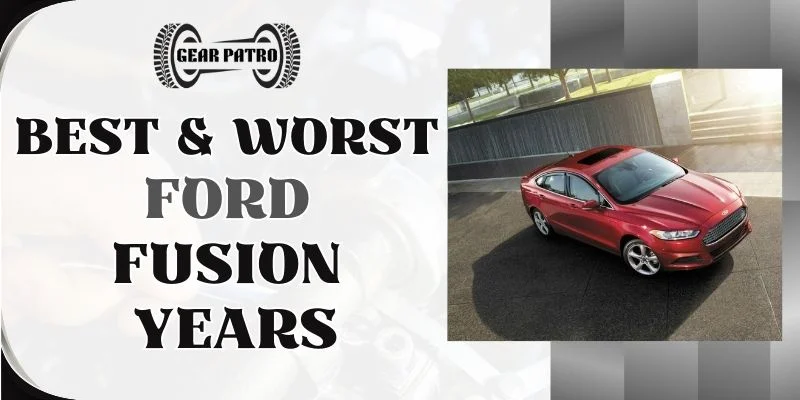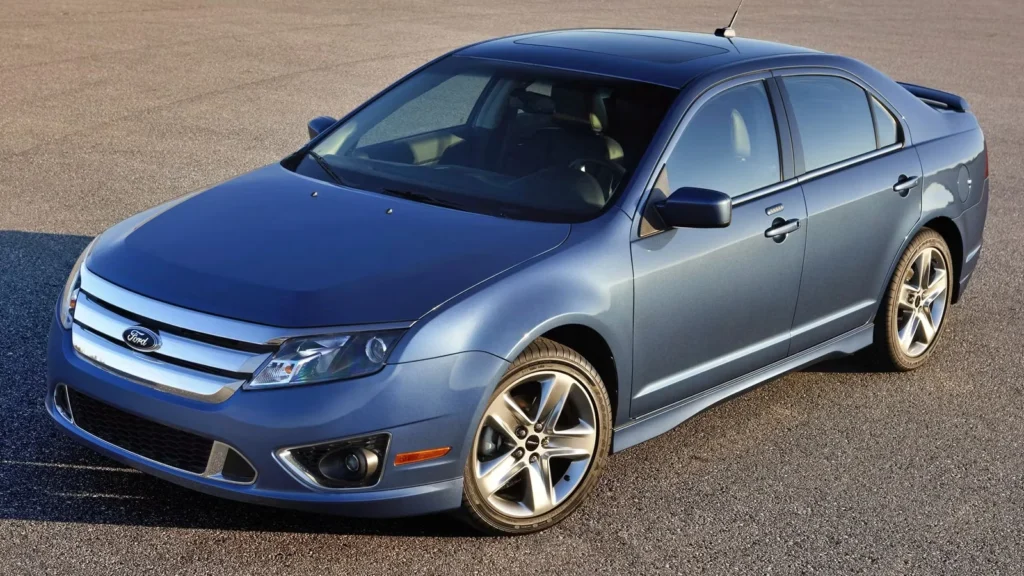To help you find the best Ford Fusion year and avoid picking the worst, we have ranked every Ford Fusion model for every generation.
This guide will show you what Ford Fusion generations are the best for purchasing and what Ford Fusion generations are the worst for purchasing.
Through extensive research from NHTSA, Consumer Reports, and VehicleHistory, I’m going to compare each model year’s performance, reliability, and overall satisfaction with data from numerous sources.

Our analysis will reveal which years of Ford Fusion have the best transmissions and power steering, and which years suffer from serious issues.
It’s time to get started.
Ford Fusion Generations
Introducing a blend of style and functionality that was quite innovative at the time, the Ford Fusion first entered the automotive market in 2006.
Between 2006 and 2020, Ford Fusion came in eight different generations. Here is a summary of those generations.
| Generation | Years |
| 1st generation (CD3) | 2006-2012 |
| 2nd generation (CD4) | 2013-2020 |
In the Ford Fusion’s history, generational changes may have determined its best and worst years. Stiles, technology, and mechanical improvements may have determined Ford Fusion’s most and least successful years.
Ford Fusion Best, Neutral, and Worst Years
Many factors were taken into consideration during our extensive evaluation and subsequent ranking of Ford Fusion’s best and worst years:
On the basis of our comprehensive analysis, we have categorized each model year of Ford Fusion into the best, neutral, and worst.
| Generation | Best Years | Neutral Years | Worst Years |
| 1st generation (CD3) | 2008 2009 | 2006 2007 | 2010 2011 2012 |
| 2nd generation (CD4) | 2017 2018 2019 2020 | 2015 2016 | 2013 2014 |
As the name implies, neutral years refer to models that did not outperform or demonstrate significant shortcomings or problems in terms of reliability or customer satisfaction.
It may negatively impact our reliability assessments if there are more NHTSA recalls and complaints.
The Ford Fusion has a rich history. Let’s take a look at its best, neutral, and worst years.
Best & Worst Years for Ford Fusion 1st Generation (2006-2012)
After entering the automotive scene in 2006, Ford’s Fusion quickly became a prominent player in the midsize sedan market.

The Ford Fusion years after its facelift – 2010-2012 – are the worst years for buying Ford Fusions, while 2008 and 2009 are the best years for buying the first-generation Ford Fusion.
The Best Years: 2008, 2009
In terms of overall user experience and number of reported problems on NHTSA, 2008 and 2009 were Ford Fusion’s best years.
As for the 2008 Ford Fusion, it was equipped with an inline-4 Duratec 23 engine, which produced 160 horsepower and 156 lb-ft of torque while delivering a fuel economy of 20 city / 29 highway mpg. A 3.0L Duratec 30 V6 engine, paired with a six-speed automatic transmission, produced 221 horsepower and 205 lb-ft of torque.
While the 2009 Ford Fusion brought along a sporty V6 AWD model and a hybrid model, it appealed to a variety of consumers.
With the addition of Ford SYNC infotainment system, technological advances were significant.
During this time, some trim levels also added anti-lock brakes and stability control as extra safety features.
The Neutral Years: 2006, 2007
Although the Ford Fusion faced a few obstacles during 2006 and 2007, it earned a reputation for being a reliable and solid vehicle.
Ford Fusion 2006 offers two engine options: a 2.3L four-cylinder engine producing 160 horsepower and 156 pound-feet of torque, and a 3.0L V6 engine offering 221 horsepower and 205 pound-feet of torque.
A five-speed manual or automatic transmission was available on the 2006 model, which had a fuel efficiency of 20 mpg in urban areas and 28 mpg on the highways. This car was available in three trim levels: S, SE, and SEL.
Despite these issues, the vehicle had electrical, airbag, and transmission malfunctions, particularly regarding the massive “Takata” airbag recall.
Although praise was given to the 2007 Ford Fusion for its smooth ride and stable handling, a recall was mandated due to problems with the ABS valve.
The Worst Years: 2010, 2011, 2012
The Ford Fusion has received an enormous number of complaints from the NHTSA in 2010, 2011, and 2012. Avoid them like the plague.
A total of nearly 5,000 complaints were received from the 2010 Ford Fusion across a variety of domains, including steering, transmission, and engine problems.
There were mainly complaints about unexpected power steering assist loss, transmission errors, and ABS malfunctions causing reduced brake performance.
Recalls also occurred as a result of prevalent issues such as fuel leaks from cracked fuel tanks and ABS valve defects that reduced brake effectiveness.
It also propelled into the limelight a class-action lawsuit regarding malfunctions of the Electronic Throttle Body.
How good are the 2011 and 2012 Ford Fusions? It’s not. There were shadows of these problems hanging over Ford Fusion models from 2011 and 2012.
A series of issues and recalls, particularly those surrounding power steering issues in Ford Fusions without 3.5L engines, have placed these years at the top of the list as the most problematic years in Ford Fusion’s first generation of vehicles.
For a list of Ford Fusion recalls and complaints from 2010, 2011, and 2012, visit the NHTSA website.
Best & Worst Years for Ford Fusion 2nd Generation (2013-2020)
In 2013, Ford Fusion introduced innovative features as well as a new design, carrying over from its predecessor.

The Ford Fusion is most reliable and best to buy in the post-facelift years – 2017-2020. Avoid the Ford Fusion years of 2013 and 2014.
The Best Years: 2017, 2018, 2019, 2020
VehicleHistory and Cars.com ratings are excellent, and NHTSA complaints and recalls are significantly lower than those in 2017. 2018, 2019, and 2020 are the top Ford Fusion years for buying a used Ford Fusion.
With a range of powertrain options, including a 2.5L Duratec four-cylinder engine, 1.5L EcoBoost turbocharged four-cylinder engine, 2.0L turbocharged four-cylinder engine, and even a V6 Sport engine, the Honda Fit offered drivers a wide range of performance options.
Featuring a powerful 325 horsepower and 380 pound-feet of torque, the V6 engine delivers an exhilarating driving experience. According to Consumer Reports, the 1.5L model has a fuel efficiency of 16 mpg city and 34 mpg highway.
The Fusion Energi and Fusion Hybrid, as well as several hybrid and plug-in hybrid variants, nodded toward an eco-friendly drive.
As a result of advanced driver-assistance technology such as adaptive cruise control, automated emergency braking, and lane-keeping assist, safety and convenience have been significantly enhanced.
There has also been a dramatic improvement in the SYNC 3 infotainment system over the past couple of model years.
The Neutral Years: 2015, 2016
The Ford Fusion remained a midsize sedan contender throughout 2015 and 2016, although it did so in an understated manner.
There were a few issues with this model that overshadowed its performance credibility, such as brake fluid leaks and steering problems, which kept reliability and owner satisfaction steady.
As part of the 2015 Ford Fusion recall, brake light malfunctions were reported, but other aspects of the vehicle remained reliable.
The 2016 Ford Fusion also suffered from some steering problems, which were echoed from previous years.
Although it exhibited relatively stable performances, it remained in the neutral category, not particularly outstanding or critically problematic.
Ford Edge Years To Avoid (Explained)
Best & Worst Ford F-150 Years | Years To Avoid
Best & Worst Ford Explorer Years | Years To Avoid
Best & Worst Ford Escape Years | Years To Avoid
Ford Focus Says Transmission Fault Service Now
Best & Worst Ford Ranger Years | Years To Avoid
Best & Worst Ford Expedition Years | Years To Avoid
Best & Worst Ford Focus Years | Years To Avoid
Best & Worst Ford F-250 Years | Years To Avoid
The Worst Years: 2013, 2014
It is highly recommended that you avoid the Ford Fusion years of 2013 and 2014 due to many recalls issued by the NHTSA regarding various domains as well as some persistent issues relating to the worst years of the first generation.
What is the outlook for the Ford Fusion in 2013? That’s not true. There were too many problems with the 2013 Ford Fusion, including coolant leaks, overheating, and transmission issues, including slipping and erratic shifting.
In addition to oil leaks caused by cracked engine cylinder heads, coolant fluid leaks, overheating in 1.6L engines, fuel leaks caused by compromised fuel delivery modules, malfunctioning door latches, unintentional rollaway due to detached shift cables, and brake fluid leaks from cracked front brake hoses, there were numerous recalls issued.
Some of these problems were found in some 2015 and 2016 Ford Fusion models as well.
Therefore, prospective buyers should avoid these early years of the second-generation Ford Fusion because they are usually characterized as problematic.
Recalls and complaints for Ford Fusion from 2013, 2014, 2015, 2016, according to the NHTSA.
Conclusion
In my evaluation of Ford Fusion models over the years, I recommend the 2017-2020 models since they offer a great combination of performance, reliability, and advanced features.
Are there any years that you have experienced that you recommend or recommend against in our guide to the best and worst Ford Fusions?
Feel free to share your thoughts and experiences in the comments below!
